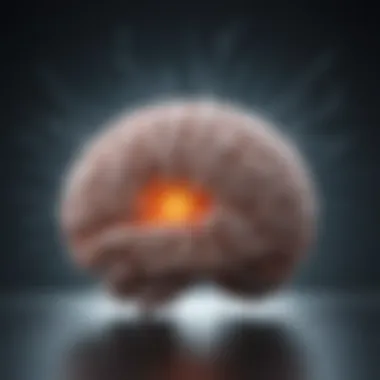Unveiling the Intricacies of Panic Attacks: A Comprehensive Insight


Wellness
Panic attacks are intense episodes that can profoundly affect both physical health and mental well-being. Understanding the physiological and psychological processes during a panic attack is crucial for managing and mitigating its effects. When a panic attack occurs, the body enters a state of heightened response, triggering various physical symptoms such as rapid heartbeat, shortness of breath, and dizziness. Simultaneously, the mind experiences intense fear and a sense of impending doom, leading to heightened anxiety levels.
Mental Health
The impact of panic attacks on mental health is profound, often leading to increased anxiety disorders and emotional disturbances. Individuals who experience panic attacks may develop a hypersensitivity to triggers, resulting in heightened states of vigilance and apprehension. The fear of a potential panic attack can further exacerbate mental distress, leading to a cycle of anticipatory anxiety. Understanding the psychological aspects of panic attacks is essential in developing coping strategies and seeking appropriate support.
Nutrition and Diet
Nutrition plays a significant role in the management of panic attacks. Certain dietary factors, such as caffeine and sugar, can trigger or exacerbate symptoms of anxiety and panic. On the other hand, consuming a balanced diet rich in whole foods, fruits, and vegetables can support overall well-being and help regulate mood and stress levels. By paying attention to dietary choices and potential triggers, individuals can better manage their anxiety and reduce the frequency and intensity of panic attacks.
Fitness and Exercise
Physical activity and exercise are essential components of managing panic attacks and promoting overall mental health. Engaging in regular exercise releases endorphins, which are known to improve mood and reduce feelings of anxiety. Incorporating activities such as yoga, walking, or running into a daily routine can help alleviate stress and tension, thus contributing to a reduction in panic attack occurrences. Prioritizing fitness and exercise as part of a holistic wellness plan can lead to significant improvements in both physical and mental health.
Introduction
Definition of Panic Attacks
Panic attacks are intense episodes of sudden and overwhelming fear or anxiety, often accompanied by physical symptoms. These episodes can be extremely distressing and may occur unexpectedly, leading to a sense of loss of control. Understanding the specific characteristics of panic attacks is crucial in identifying and addressing these episodes effectively.
Importance of Understanding Panic Attacks
Recognizing the importance of understanding panic attacks lies in the ability to navigate these episodes with greater efficiency and reduced distress. By gaining insight into the triggers, physiological responses, and psychological aspects of panic attacks, individuals can develop strategies to manage and mitigate the impact of these episodes on their well-being. This understanding not only enhances personal resilience but also contributes to a more informed and supportive community regarding mental health challenges.
Impact of Panic Attacks on Well-Being


Panic attacks can have profound effects on an individual's overall well-being, leading to increased stress levels, disrupted daily functioning, and emotional distress. The recurrence of panic attacks may also impact social interactions, work performance, and overall quality of life. By examining the repercussions of panic attacks on well-being, it becomes evident that addressing these issues is crucial for maintaining mental and emotional stability, promoting healthier coping mechanisms, and improving overall quality of life.
Physiological Responses
Understanding panic attacks entails exploring the intricate physiological responses that occur during these intense episodes, shedding light on the body's innate reactions to perceived threats. By delving into the realm of physiological responses, we can unravel the complexities that underlie the manifestation of panic attacks. This section aims to dissect the physiological mechanisms at play, offering a detailed analysis of how the body responds to stress and danger.
Fight or Flight Response
The fight or flight response is a primal instinct deeply ingrained in our biology, preparing us to either confront or flee from potential dangers. When the body perceives a threat, it triggers the release of stress hormones, such as adrenaline and cortisol, into the bloodstream. These hormones serve to heighten awareness, increase heart rate, and sharpen senses, enabling swift and efficient responses to perceived dangers.
Release of Stress Hormones
The release of stress hormones, notably adrenaline and cortisol, plays a pivotal role in priming the body for action during moments of panic. Adrenaline rapidly increases heart rate, boosts energy levels, and enhances focus, facilitating quick decision-making and physical responses. Cortisol, on the other hand, prolongs the body's state of alertness, ensuring sustained readiness to confront or evade perceived threats.
Increased Heart Rate
The escalation of heart rate is a key characteristic of the fight or flight response, essential for supplying vital organs and muscles with increased oxygen and nutrients during moments of heightened stress. By enhancing cardiac output, the body optimizes its ability to respond swiftly to threats, bolstering physical performance and reaction times in critical situations.
Dilated Pupils
Dilated pupils represent a unique feature of the fight or flight response, enabling improved visual acuity and peripheral awareness. When faced with a potential threat or danger, the body dilates the pupils to enhance light intake, sharpening vision and expanding the field of view to aid in swift decision-making and threat detection.
Role of Amygdala
The amygdala, nestled within the brain's limbic system, plays a central role in processing emotions and triggering responses to perceived threats. During panic attacks, the amygdala is hyperactivated, amplifying feelings of fear and anxiety while signaling the body to prepare for immediate action. By understanding the intricate role of the amygdala in panic responses, we can gain insight into the emotional underpinnings of these intense episodes.
Breathing Changes
Breathing patterns undergo significant alterations during panic attacks, with individuals often experiencing rapid, shallow breaths or hyperventilation. These breathing changes stem from the body's efforts to enhance oxygen intake and prepare for physical exertion in response to perceived threats. By addressing and regulating breathing patterns, individuals can mitigate the intensity of panic attacks and regain a sense of control over their physiological responses.


Psychological Aspects
The section of Psychological Aspects in the context of Understanding Panic Attacks plays a pivotal role in elucidating the intricate mechanisms at play during such episodes. By delving into the realm of human emotions and cognitive processes, this segment sheds light on the profound impact that fear and anxiety, cognitive distortions, and the sense of impending doom can have on an individual experiencing a panic attack. Emphasizing the psychological dimension allows for a holistic comprehension of panic attacks, beyond mere physiological responses. It provides a deeper understanding of the emotional turbulence and cognitive shifts that occur during these intense episodes.
Fear and Anxiety
Fear and anxiety form the core psychological components of panic attacks, driving the intense feelings of distress and unease that characterize these episodes. During a panic attack, individuals often experience an overwhelming sense of terror or impending disaster, accompanied by physical symptoms such as rapid heartbeat and shortness of breath. Understanding the interplay between fear and anxiety is crucial in deciphering the emotional landscape of panic attacks and how they manifest in both mind and body. By addressing these psychological elements, individuals can gain insight into managing the emotional upheaval that accompanies panic attacks.
Cognitive Distortions
Cognitive distortions refer to the irrational and exaggerated thoughts that individuals may experience during a panic attack. These distorted thought patterns can exacerbate feelings of fear and distress, leading to a heightened sense of discomfort and unease. By exploring cognitive distortions within the context of panic attacks, this section aims to highlight the impact of negative thinking patterns on psychological well-being. Recognizing and challenging these distortions can be instrumental in mitigating the severity of panic attacks and promoting a more balanced perspective during times of distress.
Sense of Impending Doom
The sense of impending doom is a common feature of panic attacks, where individuals feel an intense and pervasive fear of catastrophe or impending danger. This overwhelming sense of doom can trigger profound anxiety and distress, further exacerbating the intensity of the episode. By unpacking the concept of impending doom within the framework of panic attacks, this section offers insights into the psychological manifestations of extreme fear and apprehension. Understanding the origins and impact of this sensation is crucial in addressing the emotional turmoil that accompanies panic attacks and guiding individuals towards effective coping strategies.
Triggers of Panic Attacks
In this segment of the article, we delve into the crucial topic of triggers of panic attacks, shedding light on their profound significance in understanding the onset of these debilitating episodes. Identifying triggers is imperative as it allows individuals to recognize and potentially avoid situations or stimuli that may lead to panic attacks. By exploring the specific elements that can precipitate such episodes, we equip readers with valuable insights to navigate and manage their anxiety more effectively.
Stressful Situations
Stressful situations play a pivotal role in triggering panic attacks, contributing significantly to the exacerbation of anxiety-related symptoms. When exposed to high levels of stress, individuals may experience heightened physiological responses characterized by increased heart rate, shallow breathing, and a sense of impending doom. Understanding the impact of stressful situations as triggers for panic attacks underscores the importance of stress management techniques in mitigating the risk of such episodes.
Phobias and Fears
Phobias and fears represent another critical trigger for panic attacks, eliciting intense feelings of fear and anxiety in affected individuals. Whether stemming from specific phobias or deep-seated fears, these triggers can prompt overwhelming panic reactions, manifesting as physical symptoms like palpitations, sweating, and trembling. By examining how phobias and fears contribute to the development of panic attacks, we emphasize the significance of confronting and addressing underlying fears to prevent their escalation.


Traumatic Events
Traumatic events serve as potent triggers for panic attacks, generating profound emotional distress and triggering maladaptive coping mechanisms. Individuals who have experienced traumatic events may be more susceptible to heightened anxiety responses, characterized by intrusive thoughts, hypervigilance, and emotional dysregulation. Exploring the impact of traumatic events as triggers for panic attacks underscores the need for trauma-informed care approaches to support individuals in processing and healing from their past experiences.
Common Symptoms
Understanding panic attacks involves a detailed examination of the common symptoms that manifest during these episodes. This section plays a crucial role in shedding light on the physical and emotional signs that individuals may experience when encountering a panic attack. By elucidating the common symptoms, we can develop a deeper understanding of the distressing nature of panic attacks and their impact on overall well-being. In this comprehensive guide, we will delve into the specific elements, benefits, and considerations associated with common symptoms, aiming to provide a nuanced perspective on this significant aspect of panic attacks.
Heart Palpitations
Heart palpitations are a notable symptom observed in individuals experiencing panic attacks. These palpitations manifest as a racing or irregular heart rate, often accompanying feelings of intense fear or anxiety. Understanding the prevalence and significance of heart palpitations during panic attacks is essential for recognizing the physiological responses associated with heightened stress levels. By exploring the intricacies of heart palpitations in the context of panic attacks, we can gain valuable insights into the body's autonomic arousal and the interplay between emotions and physical sensations.
Sweating and Trembling
Sweating and trembling are common physical symptoms that accompany panic attacks, indicative of the body's heightened stress response. The emergence of sweating and trembling during a panic attack underscores the body's instinctual reaction to perceived threats or dangers, contributing to the overwhelming sense of fear and discomfort experienced during these episodes. By delving into the mechanisms behind sweating and trembling in the context of panic attacks, we can unravel the physiological processes tied to the body's fight-or-flight response, offering a comprehensive view of the body's interconnectedness with emotional states.
Nausea and Dizziness
Nausea and dizziness represent prominent symptoms that individuals may confront during a panic attack, further amplifying the distressing nature of these episodes. The presence of nausea and dizziness underscores the intricate relationship between psychological distress and physical manifestations, illuminating the holistic impact of panic attacks on an individual's well-being. By examining the physiological and psychological underpinnings of nausea and dizziness in the context of panic attacks, we can garner a deeper appreciation for the complex interplay between emotions, cognition, and bodily responses in times of heightened stress.
Coping Strategies
Coping strategies play a pivotal role in managing and mitigating the impact of panic attacks. This section delves into the significance of coping strategies within the context of understanding panic attacks. By implementing effective coping mechanisms, individuals experiencing panic attacks can navigate through these episodes with greater resilience and control. It is essential to recognize that coping strategies vary from person to person, reflecting the diverse ways individuals respond to stress and anxiety. Understanding the specific coping strategies that work best for oneself is paramount in promoting mental well-being and emotional stability.
Deep Breathing Exercises
Deep breathing exercises constitute a fundamental component of coping strategies for panic attacks. Through deliberate and controlled breathing techniques, individuals can regulate their physiological responses to stress and anxiety. Deep breathing encourages the activation of the parasympathetic nervous system, promoting relaxation and reducing the intensity of panic attack symptoms. By focusing on slow, deep breaths, individuals can engage in mindfulness and redirect their attention away from distressing thoughts. Incorporating deep breathing exercises into a daily routine can enhance resilience to panic attacks and foster a sense of calmness amidst stressful situations.
Mindfulness Meditation
Mindfulness meditation serves as a powerful tool in cultivating self-awareness and emotional regulation, crucial aspects of coping with panic attacks. By practicing mindfulness meditation, individuals can develop a non-judgmental awareness of their thoughts and emotions, allowing them to observe and accept rather than react impulsively. This heightened sense of awareness enables individuals to reduce the impact of triggers that contribute to panic attacks and foster a sense of inner peace and tranquility. Mindfulness meditation empowers individuals to ground themselves in the present moment, fostering resilience and enhancing psychological well-being.
Seeking Professional Help
Seeking professional help is a proactive step toward effectively managing and mitigating the impact of panic attacks. Professional assistance from therapists, counselors, or mental health professionals can provide individuals with the necessary tools and strategies to address underlying issues contributing to panic attacks. Through therapy sessions, individuals can gain insights into their thought patterns, learn coping mechanisms, and develop personalized strategies to navigate through panic attacks successfully. Seeking professional help not only offers emotional support but also equips individuals with the resources to build long-term resilience and enhance their overall well-being.



